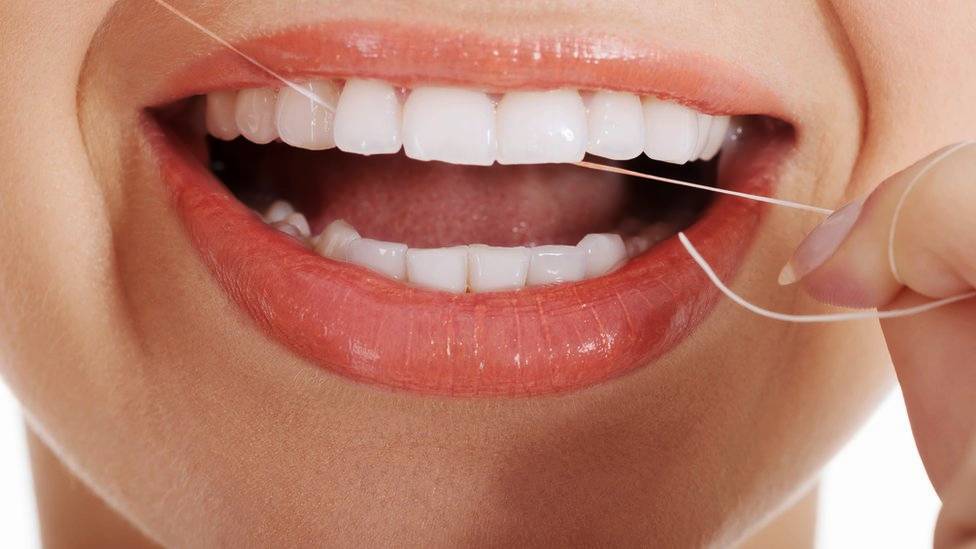When we brush our teeth we clean the top surfaces, the front surface, and the back surface, what about the surface between the teeth?
Can brushing clean the space or area between the teeth?
Isn’t that are of the teeth involved in the eating process?
Our brush can’t reach that area, the soft bristles only reach the three surfaces as I mentioned.
So, what about the surface between the teeth?
This is where flossing comes into play.
Flossing removes the food particles stuck in between the teeth and prevents your gums from getting irritation or infection due to food decaying or rotting.
Although flossing has become a controversial topic, thanks to the U.S. department of health and human services and agriculture.
In its latest released dietary guidelines, flossing is not included in the daily health regimen.
But, as per their findings and research, flossing improves dental hygiene and prevents gum diseases and tooth decay. In other words, well it is not essential to floss every day, but if you do floss every day, that’s better for you. You can visit our Paragon Dental Centre for a complete checkup.
Thanks to their latest reports, they also removed the ambiguity or one of the hottest questions related to flossing; does flossing causes teeth to gape?
As per this latest report, flossing removes cavities or gum disease from the areas and is not a cause of teeth gaps.
But those who start flossing, about all of them come with complaints that the gaps between their teeth have been increased, and they can feel it.
Why do they feel like that?
Let’s try to unearth the underlying cause, and shed light on one of the hot topics.
Does flossing cause teeth gaps?
First thing first, 4 out of 10 American don’t floss at all, that’s the stat for those who visits their dentist on regular appointments.
If you look at the overall population, around 20 percent of people don’t floss at all. And even if someone after reading about the benefits of flossing starts it, the misconception that flossing c creates gaps between the teeth and skip flossing.
Well, that’s true. When you start flossing you may feel there is a gap. Actually, in that gap, there was plaque buildup formerly, which has now been removed. The plaque, the build-up of bacteria, which was the biggest cause of bad oral hygiene, bad breath, or tooth irritation has now been removed from your teeth.
It’s for those who started flossing for the first time. For the next 1-2 weeks you may feel an excessive gap between the teeth.
With time, if you continue flossing, slowly within 2-4 weeks the gum’s irritations will be healed, the area will be taken by your gums, and the gap would be eliminated.
But if you are not following the right techniques for flossing, or doing it incorrectly, there is a chance that your teeth develop gaps between them. So, there is the possibility of gaps between the teeth due to flossing, but that’s when you don’t do it properly, and follow an incorrect method.
Let me list down some very common mistakes that people commit that lead to gaps between the teeth.
Common Flossing Mistakes
1. If you cut your gums
When you start flossing for the first time, you don’t know the right technique and in the haste of putting the floss in between the teeth, you may snap down the floss and cut the gums.
Not only can bleed the gums but can be painful and after that event for a few next days, you might not be able to floss that tooth again.
2. Stops Flossing due to gums bleeding
If you floss and experience bleeding gums, that means there has been a plaque build-up between your teeth. That’s a sign that there was irritation and inflammation in the gums, most of the people who start flossing for the first time stop flossing after such events.
If you too experience something like that you should not stop flossing, this is a sign that there is a build-up of plaque and bacteria that needs to be removed for healthy gums and teeth.
So, these were some flossing mistakes. What is the correct method of flossing, and how should floss to get the right benefits of flossing?
How to floss properly to prevent gaps between the teeth?
If you have just started flossing and experience gaps between the teeth, don’t stop flossing. Floss properly, in addition to twice a day brushing and regular dentist visits.
Start flossing by taking an 18 inches string, you may buy a flossing tool online too, that comes with threads to help you pull one in one time.
Wind most of the floss thread to your middle fingers on both hands. Hold the floss tight using your forefinger and thumb.
Now start flossing between the teeth, guide the thread slowly in sawing motion, don’t rush, and guide the thread slowly to avoid snapping. Snapping will lead to gum bleeding, and pain which can lead to irritation and receding gums over time.
Move the floss up and down, when it touches the floss line, move it into the C-shape to completely remove all the build-up and plaque. Don’t worry if the floss smell awful, that’s because food particles have been there for days and now have been decayed or decomposed which involves sulfur gas production.

